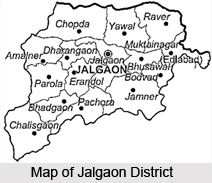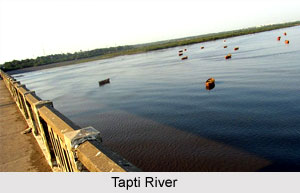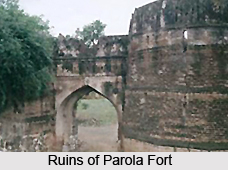 Jalgaon district is located in the state of Maharashtra. It hosts a population of about 4 million in an area of about 11,700 sq km. It is abounded by many religious places and cultural establishments. The major tourist attractions are Pal hill station at Raver, Patnadevi temple at the confluence of Tapi and Purna River and hot water springs at Unapdev in Chopda Taluka. The world famous heritage site of the Ajanta Caves is near to Jalgaon (50 kms) making it one of the major international tourist hubs. The district has excellent rail and road connectivity and is a central destination to reach out to major places in India. It is a major business centre for tea, gold, pulses, cotton and bananas. Banana and cotton are Jalgaon`s main crops. Jalgaon district is known for its advances in horticulture. Its production of bananas and cotton, especially by resorting to drip irrigation, has created a role model for cultivators in other parts of India. Bananas grown in the district are exported outside the state and to other countries. Jalgaon is the largest banana growing district in India. Jalgaon is also growing up as a premier educational place with many colleges in the field of engineering and computer science. Modern Jalgaon now boasts of a vast industrial area, educational institutes and good hospitals.
Jalgaon district is located in the state of Maharashtra. It hosts a population of about 4 million in an area of about 11,700 sq km. It is abounded by many religious places and cultural establishments. The major tourist attractions are Pal hill station at Raver, Patnadevi temple at the confluence of Tapi and Purna River and hot water springs at Unapdev in Chopda Taluka. The world famous heritage site of the Ajanta Caves is near to Jalgaon (50 kms) making it one of the major international tourist hubs. The district has excellent rail and road connectivity and is a central destination to reach out to major places in India. It is a major business centre for tea, gold, pulses, cotton and bananas. Banana and cotton are Jalgaon`s main crops. Jalgaon district is known for its advances in horticulture. Its production of bananas and cotton, especially by resorting to drip irrigation, has created a role model for cultivators in other parts of India. Bananas grown in the district are exported outside the state and to other countries. Jalgaon is the largest banana growing district in India. Jalgaon is also growing up as a premier educational place with many colleges in the field of engineering and computer science. Modern Jalgaon now boasts of a vast industrial area, educational institutes and good hospitals.
Location of Jalgaon District
Jalgaon district is located in the north-west region of the state of Maharashtra. It lies between 20 degrees and 21 degrees north latitudes and east longitudes of 74 degrees 55 minutes and 76 degrees 28 minutes. It is bounded in the North by the Satpura mountain range, Aurangabad district and Nashik district in the south, Madhya Pradesh and Buldhana in the east and Dhule in the west. The Ajanta mountain ranges lie in the south.
 History of Jalgaon District
History of Jalgaon District
Much of the early history of Jalgaon district is obscure. It was part of a region known as Rasika in ancient times, and after the region came under the rule of the Farqui Kings, it came to be called Khandesh. The Vakataka dynasty, the Nizams of Hyderabad, and subsequently the Marathas ruled the region. In 1906 when Khandesh was divided, east Khandesh became present-day Jalgaon. In 1956 with the reorganisation of states, it was included in Bombay state, and with the formation of Maharashtra in 1960, Jalgaon became a district of the state.
 Geography of Jalgaon District
Geography of Jalgaon District
Jalgaon has got a pretty diverse climate. It is exceptionally hot and dry during summer with temperatures reaching as high as 45 degrees Celsius. Jalgaon receives about 700 mm rainfall during monsoons, which is followed by pleasant temperature in winter. The principal natural feature of the district is the Tapti River. Unlike the rest of the Deccan, whose rivers rise in the Western Ghats mountain range and flow eastward to the Bay of Bengal, the Tapti flows westward from headwaters in eastern Maharashtra to empty into the Arabian Sea. The Tapti receives thirteen principal tributaries in its course through Kandesh. None of the rivers is navigable, and the Tapti flows in a deep bed which historically made it difficult to use for irrigation. Most of Kandesh lies south of the Tapti, and is drained by its tributaries the Girna river, Bori river and Panjhra. The alluvial plain north of the Tapti contains some of the richest tracts in Kandesh, and the land rises towards the Satpura hills. In the centre and east the country is level, save for some low ranges of barren hills. To the north and west, the plain rises into rugged hills, thickly wooded, and inhabited by the people of the Bhil tribe.
Culture of Jalgaon District
The Marathi language is the language of the locals. People speak the Hindi language in the areas bordering Madhya Pradesh. The staple food of the people is millets, wheat and rice. Four main fairs are held in the district which attracts a number of devotees not only from within the district but also from the rest of the state. These are: the Shri Rama Rathotsava fair at Jalgaon town, held during the Hindu month of Kartik; the Navaratri-Mahalaxmi fair at Jalgaon town during Navaratri (October-November); Changdeo fair at the Changdeo temple located about 6 kms northwest of Edlabad, and the Mukatabai fair held again in Magha at Kothali, in Edlabad tehsil.






